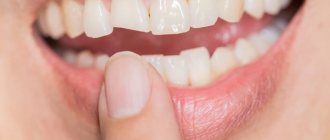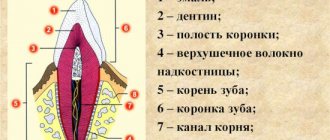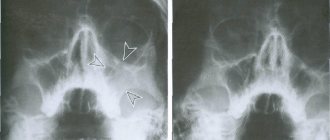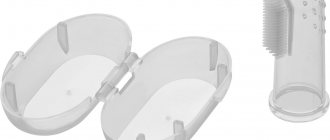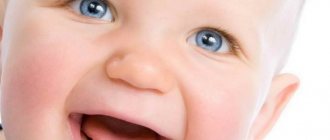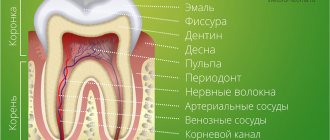What parents need to do
- Parents must demonstrate that teeth should be brushed on all sides;
- Move the brush from the gum to the edge of the tooth. For the first teeth, you need to choose a special children's toothpaste and a brush with soft bristles. Teeth cleaning gel is best.
- There is no need to choose toothpaste with excessive fluoride content. While brushing teeth, the child involuntarily swallows the toothpaste, and fluoride can cause irreparable harm to the child’s body.
By the age of 3, children have already mastered the technique of brushing their teeth well, but parents should always be present when brushing their baby’s teeth.
Between the ages of 5 and 12 years, a child's molars begin to erupt. At this time, the enamel on the teeth begins to mature, so you can already use toothpaste containing fluoride.
Parents have the opinion that damaged baby teeth do not need to be treated, because they will fall out anyway. This is an erroneous opinion and caries that appears on baby teeth must be cured.
Clinical researches
Clinical studies of anti-sensitive toothpaste “Asepta Sensitive”, conducted at the Department of Therapeutic Dentistry of St. Petersburg State Medical University named after. acad. I.P. Pavlova, conducted over 4 weeks, found that:
- When probands used the Asepta Sensitive therapeutic and prophylactic toothpaste, there was a significant improvement in the hygienic and periodontal conditions of the oral cavity and a decrease in the increased sensitivity of the hard tissues of the teeth, which was confirmed by the positive dynamics of clinical indices.
- After just two weeks, a pronounced decrease in the increased sensitivity of hard dental tissues in probands was observed due to the desensitizing effect of the therapeutic and prophylactic toothpaste used.
Asepta Sensitive toothpaste has been shown to have a good anti-inflammatory effect on inflamed, swollen and bleeding periodontal soft tissues.
During the tests, it was found that under the influence of Asepta Sensitive toothpaste, there was a significant reduction in gum bleeding.
Regular use of this therapeutic and prophylactic agent led to a significant improvement in the general dental status of the probands, which confirmed the validity of its use in the complex of ongoing therapeutic and preventive measures.
According to the results of clinical trials of the ASEPTA® rinse, it was found that after 3 weeks of using the ASEPTA® rinse, gum bleeding decreases by 28.3%, inflammation decreases by 32.3% and the hygienic condition of the oral cavity improves by 33.5%.
Sources:
- Clinical studies of antisensitive toothpaste “Asepta Sensitive” (A.A. Leontyev, O.V. Kalinina, S.B. Ulitovsky) A.A. LEONTIEV, dentist O.V. KALININA, dentist S.B. ULITOVSKY, Doctor of Medical Sciences, Prof. Department of Therapeutic Dentistry, St. Petersburg State Medical University named after. acad. I.P. Pavlova
- Report on clinical trials to determine/confirm the preventive properties of commercially produced personal oral hygiene products: mouth rinse "ASEPTA PARODONTAL" - Solution for irrigator." Doctor of Medical Sciences Professor, Honored Doctor of the Russian Federation, Head. Department of Preventive Dentistry S.B. Ulitovsky, doctor-researcher A.A. Leontiev First St. Petersburg State Medical University named after academician I.P. Pavlova, Department of Preventive Dentistry.
- Report on determining/confirming the preventive properties of commercially produced personal oral hygiene products: Asepta toothpaste used in combination with Asepta mouthwash and Asepta gum balm Head. Department of PFS Doctor of Medical Sciences Professor S.B. Ulitovsky St. Petersburg State Medical University named after Academician I.P. Pavlova. Faculty of Dentistry. Department of Preventive Dentistry.
Age-related changes in dental growth and development
As soon as teeth (both milk and permanent) begin to erupt, they become vulnerable to the external environment, but at the same time they acquire a protector in the form of saliva, which not only helps destroy bacteria, but is also directly involved in saturating the teeth with various minerals. The first to experience age-related changes are enamel and dentin. Every year, due to the erosion of enamel, our teeth decrease in height. The average is about 0.035 millimeters per year, but some people experience increased tooth wear due to anatomical features and bad habits. The color and structure of the enamel change: more and more dyes accumulate in it, which leads to yellowing and loss of shine. Cracks and microdamages form on the surface of the enamel, where plaque penetrates. Over time, it mineralizes and prevents the penetration of organic substances and beneficial microelements into the enamel. It should be remembered that enamel cannot be restored, so in case of damage or illness, you should consult a doctor promptly and not wait for complications to arise. As for dentin, over the years it regenerates more and more slowly, and the quality of replacement dentin also becomes worse.
Features of the process of the appearance of molars
The rudiments of permanent teeth are formed in the child in the womb in the fifth month of pregnancy. If no violations occurred during this period, then at about the age of one year, babies begin to develop molars inside their tissues. That is why the condition of baby teeth plays a big role. Any infection and pathology can affect this process.
Normally, by the age of 5–6 years, a child may exhibit symptoms of the eruption of the first molars:
- increased salivation;
- Possible runny nose or nasal congestion;
- increase in jaw size;
- loosening of a baby tooth;
- swelling of the gums;
- loss of a baby tooth;
- sore gums;
- elevated temperature;
- eruption of a permanent tooth.
At the moment when molars in children begin to grow and cut through the soft tissue of the gums, the root of the baby tooth is reabsorbed, which subsequently falls out on its own. The gum may be open for some time, then it heals. Between the loss and growth of teeth, it can take from several days to 2-3 weeks.
Age-related changes in bone tissue and gums
In addition to age-related changes in teeth, over the years a person, as a rule, decreases bone density and its height. Osteoporosis of the jaw often occurs in older people. The clinical picture is aggravated by adentia (partial or complete) and poor-quality dentures, due to which the distribution of the chewing load is disrupted. Changes can affect not only hard but also soft tissues. Age-related gum recession occurs both due to previous diseases (for example, periodontitis), and due to poor genetics, poor lifestyle and bad habits, especially smoking. At an advanced stage, this leads to loosening and loss of teeth.
Age-related changes in dental pulp
Regressive and age-related changes in the dental pulp also affect dental health. Over the years, the pulp decreases, and fibrous changes are often observed in its tissues. Mineral deposition negatively affects the condition of blood vessels and capillaries. Atherosclerosis of pulp vessels occurs in many people over 50 years of age. Because of this, tooth tissues no longer receive proper nutrition, which is why they become more fragile and vulnerable. Many people are interested in how to determine a person’s age by looking at their teeth. Only a medical examination can provide more or less accurate data. It is very difficult to determine a person’s age by looking at their teeth, since even relatively young people’s teeth can be in very poor condition, and vice versa.
Note!
We draw your attention to the fact that each child’s body is strictly individual and there are no “strict deadlines for the eruption and loss of teeth”; we can only clearly identify the sequence of appearance of teeth in the mouth. All terms are given with a certain degree of convention (±2-3 months), based on the most common situation in the practice of dentists. Therefore, do not be alarmed if the number of teeth in your baby’s mouth does not correspond to the tabulated data. To be more sure or if something worries you, it is recommended to show your baby to a pediatric dentist.
Please note that all information is provided for informational purposes only.
What teeth appear in each age period?
At the age of 6-8 months, the baby's first tooth erupts. Primary upper and lower incisors usually erupt by the first year of life, and the formation of a full set of primary teeth should be completed by three years. The replacement of baby teeth with molars (permanent) begins at five to six years of age, and by the age of twelve to thirteen, the bite of the molars should be formed.
The tooth begins to erupt at the moment when the crown has completed its formation inside the jaws. The formation of the tooth root continues as it erupts and lasts one and a half to two years.
In order for the information to be perceived conveniently by parents, even those who are very far from dentistry, we have identified several CONDITIONAL age stages of development of the maxillofacial part. We have tried to highlight diseases of the teeth, gums and oral cavity in general that are characteristic of a specific age period and methods that will help to cope with this disease as effectively as possible.
In the sections we have created you can find a lot of useful information and get answers to questions. You will be able to find out how many teeth a baby should have at a particular age, why, when the first milk teeth erupt, the gums itch, why the teeth erupt at random, what treatment methods are available at different age periods and in what sequence both milk and molar teeth erupt .
We've identified common problems for each age period and described what aspect of your baby's oral health you need to pay special attention to at each specific moment. For example, the main reason for the development of caries in a one and a half year old baby is night feeding. The likelihood of developing “bottle” caries will decrease significantly, you just have to give up this bad habit, which has ceased to be a necessity after the first year of a child’s life.
Note!
But do not forget that each baby’s body is individual and there are no strict deadlines for the eruption and loss of primary and permanent teeth; only the sequence in which teeth appear in the oral cavity can be clearly identified. All the periods indicated by us are given with a degree of convention equal to two to three months, up or down, based on the most common situations encountered in the practice of dentists. Therefore, there is no reason to worry if the number of teeth in your baby’s mouth does not match the tabular data. But, if something worries you or you want to make sure that your child’s health is not in danger, the pediatric dentists at the 32 Dent clinic are waiting for you and your baby for an appointment.
Possible problems when changing teeth
The eruption of baby teeth causes a lot of worries and problems, since often the first teeth come through very painfully and the baby becomes capricious, sleeps poorly and refuses to eat.
There are no such problems with the growth of molars, but more serious difficulties may arise:
- delayed eruption;
- preservation of baby teeth;
- growth of a superset of teeth;
- displacement, torsion and other malocclusions;
- absence of molars.
All these pathologies can be the result of hereditary predisposition, gene mutations, problems with intrauterine development, jaw trauma, immunodeficiency diseases, mineral deficiencies, diseases of the oral cavity or baby teeth.

